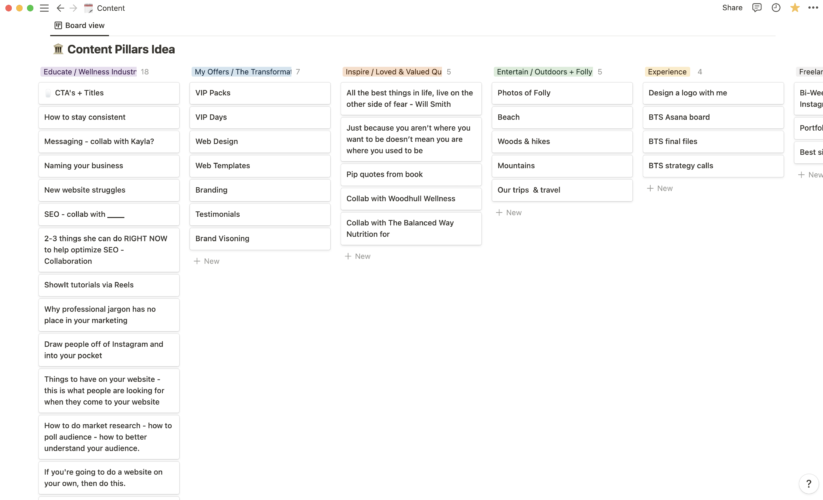About Lizzy
White Point Creative’s owner and lead designer, Lizzy, currently works out of Fredericksburg but grew up surfing in Charleston, SC. Married to the love of her life, Joe, they live for time outdoors and finding the best brunch spots with their pups Folly & Daisy.
CATEGORIES:
design
For Designers
business
personal
free checklist to doubling your revenue & cutting your working hours
Unlock the 6 Essential Elements To A Thriving Brand
yes! i need this
I love love love talking about all things marketing and content. So much so, I have an entire package dedicated to it [insert link]. Having a focused backlog of content and ideas as well as a way to follow through with these ideas, has been hugely important to my business’s growth. But more importantly, having a content flow has allowed me to connect with my audience on a deeper level which has created meaning and trust. And let’s be honest, without trust, no one is going to buy from you.
In fact, by creating a content marketing workflow I 100% believe we can get you…
- Creating the flourishing businesses of your dreams
- Launching a physical product shop that evokes trustworthiness and confidence.
- Earning money through multiple streams of income.
Disclaimer: Creating a content marketing flow will not automatically bring you all of those things. Sorry to burst your bubble, it will take a little more than that. HOWEVER, I whole-heartedly believe that a content marketing flow is a foundational step in the process and integral to any businesses growth.
With all of this in mind, in today’s blog post I am explaining – top to bottom – how to create, implement, and repeat your very own content flow as a way to grow an audience, earn an income, and affect people’s lives.
Let’s Get Specific
First of all, I want to get really specific about what exactly is content marketing and what a content marketing flow is.
- Content marketing is a strategy focused on creating and distributing valuable, relevant content, consistently, to attract and retain a clearly pre-defined audience — and, ultimately, to drive profitable customer action.
- A content marketing flow is a thoughtfully formatted flow in which you plan, write, design, and execute your business’s marketing content in a way that is repeatable and consistent.
Secondly, I want to chat about why content marketing is so important. Content marketing can do so much for your business including:
- Help you grow your email list and audience.
- Give you clarity on your sales funnel.
- Create an engaging following of fans.
- Build your authority and credibility.
- Not to mention grow your traffic!
Now let’s dive in!
Define Your Audience
So that we start off on the right foot, I want you to first be extremely clear about who this content is supposed to attract. The “pre-defined audience” will ultimately take action that puts $$ into your bank account. There are so many strategies to help you define this audience which we will talk about in a later post. For now, get as specific as possible about their wants, needs, and pain points.
Commit To Being Consistent
Next, you want to decide on where you want to show up for your audience and present your valuable information. It’s so easy to become over-enthusiastic and overcommit ourselves. You need to get really honest with yourself, and your schedule so that you can be consistent and avoid burnout. Start with a single outlet, and master it. Once it is second nature and takes you no time to whip up, strategize about adding another.
Maybe you love talking but hate being on camera. In your case, I would suggest a podcast. Maybe you really enjoy writing and find that you have a gift for guiding readers through a written process; for you, I would recommend blogging!
Other ideas include:
- Webinars
- Instagram posts + stories
- Youtube videos
- Email newsletters
- Facebook Live
If you’re a little stuck or can’t decide then think about how your audience would best digest the information and what platforms they are most active on. Knowing your audience well, will help you decide on a platform. Establishing where to show up for your audience needs to be a combination of what you’re amazing at as well as how your audience prefers to learn.
Another consideration is your budget. Some platforms are free, however, you are only renting space and you cannot control all of the elements whereas some paid platforms allow you to control more variables but become a monthly or yearly line item.
Determine Your Buckets
I know that title seems a little funky, but track with me. You need a system of sorting through and tagging the type of information you give out. In the marketing and creative industry we commonly refer to these different piles of information as “buckets”.
What topics are you passionate about? What topics does your audience want to hear about? What burning questions do they have? What do they want to learn about?
Defining your buckets has a similar balancing act as defining your platform. You want these topics to resonate with your audience and you want to become a consistent go-to source. However, you also don’t want to write about things that bore you because it will likely become apparent that your passion is lacking when you start writing.
Work on defining 3-6 buckets that are educational, entertaining, and personal. Note that each style of bucket (ex. educational) has a different goal.
- Educational topics establish trust and begin to position you as an expert in your field. Don’t talk or write about things you don’t know inside and out.
- The goal with entertaining and personal topics is to establish likeability and relatability.
If you’re struggling to define your own buckets, then research your competitors’ topics but do not steal, you’re better than that. You can also research individuals outside of your niche to see how they are approaching their audience; think of them as a case study.
Plan Your Content
The ultimate goal is to become so proficient in planning, writing and publishing your content that you can do a months’ worth in just a few days, we call this batching or batch working. I personally use this method because it makes life 1000x easier and allows me to brain dump everything and then put my mind on the back burner.
There are lots of ways of planning your content but a few methods I’ve seen work well:
- Keep a running list of ideas with a simple outline in a google doc (personal favorite).
- Keep a google sheet organized with topics, tags, authors, publish date, team members…etc. (This one is particularly effective for larger teams).
- Create a Notion board (This option is nice because there are hundreds of ways to organize a Notion board).
- Create an Asana board of ideas with topics as the column titles.

Start Writing Your Long Version
Even if you aren’t going to employ a blog, the minimum you should be writing out is a detailed outline with bullets, sub-bullets, and sub-sub-bullets.
Now depending on your primary platform, this outline or long-form document will look different but the general idea is to get everything out, organized, and refined.
Pro tip: If you are blogging then please also be conscious of SEO strategies by making sure your keywords are everywhere including the body copy, headings, and title as well as photograph description and photograph name (How-To-Create-A-Content-Marketing-Flow-White-Point-Creative.jpg).
Break It Up
If you are using your content on a single platform then skip this step.
Now it’s time to break up your content into smaller, but still informative bits to then divide between the multiple platforms you employ.
My long version tends to be around 1500 words which allows me to break my content up into something like:
- 1-3 Instagram posts + 3-10 stories for each post
- 5-10 Pinterest pins
- 1-2 Email newsletters + a possible opt-in/freebie
Yours will look different of course, but create a goal for each platform and keep in mind that your long version isn’t always read so if someone ONLY reads your Facebook post, it should still make sense and be helpful.
Create Visuals
The fun part! At least for me haha I keep an Illustrator file full of templates for each platform I use. You can do the same thing on Canva or similar websites. Why use templates? Consistency!
You want your brand to be recognizable across multiple platforms and uniquely yours. If designing your own content, even from templates, is just too time-consuming or complicated then look into hiring a designer on a monthly basis to do all of this for you! Here at White Point we do this with some of our favorite clients who just don’t have the bandwidth to design their own assets. So at the end of their batch days, they send us every version they need to be designed (ex. 3 facebook posts, 3 instagram posts, 8 pinterest pins and 1 freebie) along with the copy and we do the work for them in a single day! Best of both worlds right?
Schedule The Thing
And finally, schedule all of your content. Most platforms do not like it when you dump all of your amazing content all at once, they consider it spammy.
Platforms like Tailwind for Pinterst, Later for Instagram, and so much more are here to help.
Pro tip: Don’t just plan, auto publish, and walk away. You need to be engaged with your audience! Plan time to be on your platforms DMing, commenting, and liking other content. They are called social networks for a reason. Be social in your own unique way!
Let’s Do A Quick Review Because That Was A Lot Of Information!
- Pick your primary platforms.
- These should be the platforms you show up on consistently.
- Plan your content.
- Keep a running list of inspiration and ideas, we like using a google doc and google sheet.
- Start with your longest version and outline it in detail. Then write it up.
- This is usually your blog or newsletter.
- Break your long version into multiple smaller versions to be scheduled into your primary platforms.
- 1-3 Instagram posts + stories
- 1-3 Facebook posts
- 3-5 Pinterest pins
- 1-2 Email newsletters + a possible opt-in/freebie
- Create visuals to go along with each.
- Using canva or passing along to your designer on retainer (shameless plug).
- Schedule your posts.
- Make sure you are still showing up and being social!
To help with the planning process I have created this amazing freebie!

